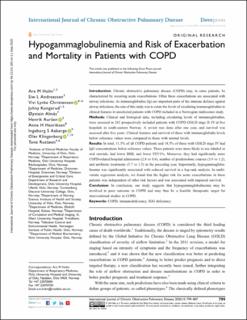| dc.description.abstract | Introduction: Chronic obstructive pulmonary disease (COPD) may, in some patients, be characterized by recurring acute exacerbations. Often these exacerbations are associated with airway infections. As immunoglobulins (Ig) are important parts of the immune defence against airway infections, the aim of this study was to relate the levels of circulating immunoglobulins to clinical features in unselected patients with COPD included in a Norwegian multicenter study.
Methods: Clinical and biological data, including circulating levels of immunoglobulins, were assessed in 262 prospectively included patients with COPD GOLD stage II–IV at five hospitals in south-eastern Norway. A revisit was done after one year, and survival was assessed after five years. Clinical features and survival of those with immunoglobulin levels below reference values were compared to those with normal levels.
Results: In total, 11.5% of all COPD patients and 18.5% of those with GOLD stage IV had IgG concentrations below reference values. These patients were more likely to use inhaled or oral steroids, had lower BMI, and lower FEV1%. Moreover, they had significantly more COPD-related hospital admissions (2.8 vs 0.6), number of prednisolone courses (3.9 vs 1.2), and antibiotic treatments (3.7 vs 1.5) in the preceding year. Importantly, hypogammaglobu- linemia was significantly associated with reduced survival in a log-rank analysis. In multi- variate regression analysis, we found that the higher risk for acute exacerbations in these patients was independent of other risk factors and was associated with impaired survival.
Conclusion: In conclusion, our study suggests that hypogammaglobulinemia may be involved in poor outcome in COPD and may thus be a feasible therapeutic target for interventional studies in COPD. | en |
